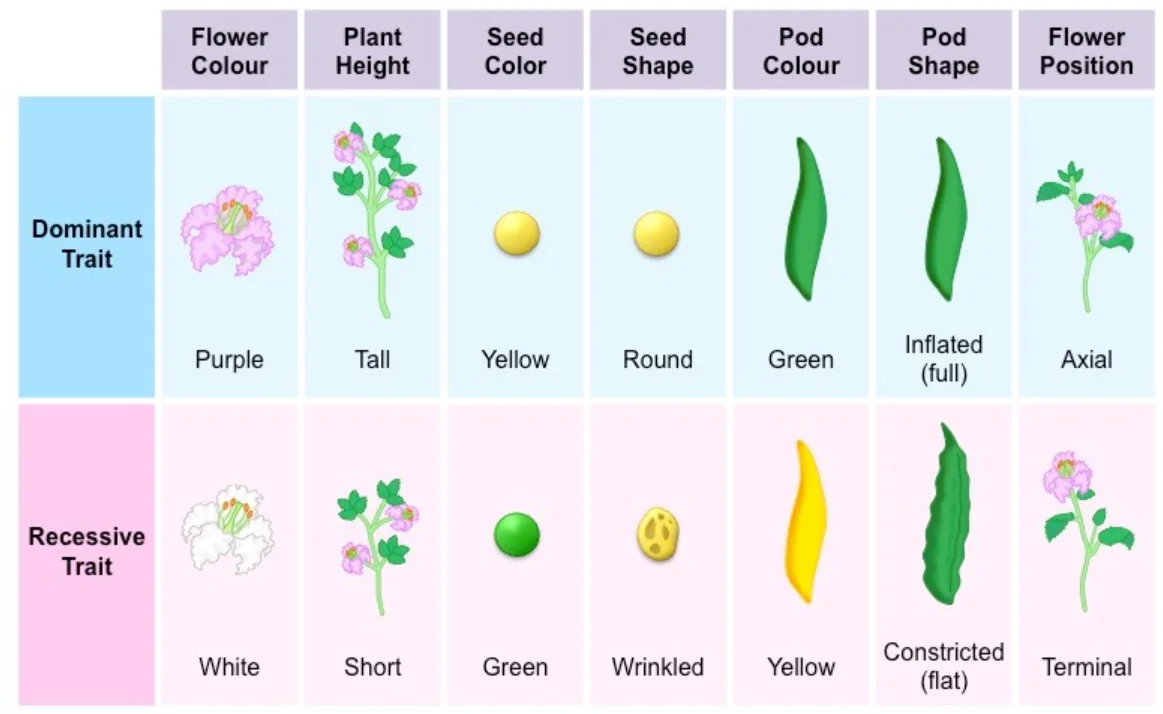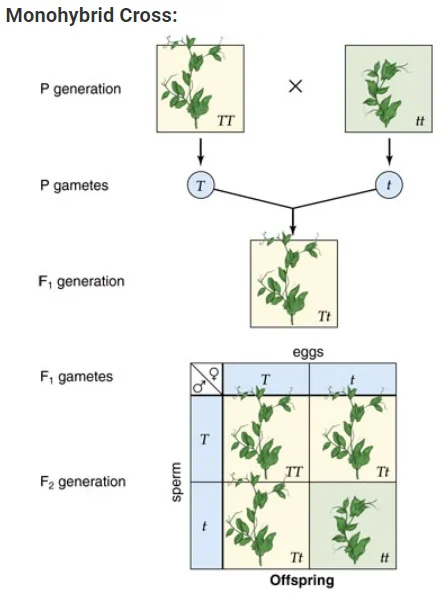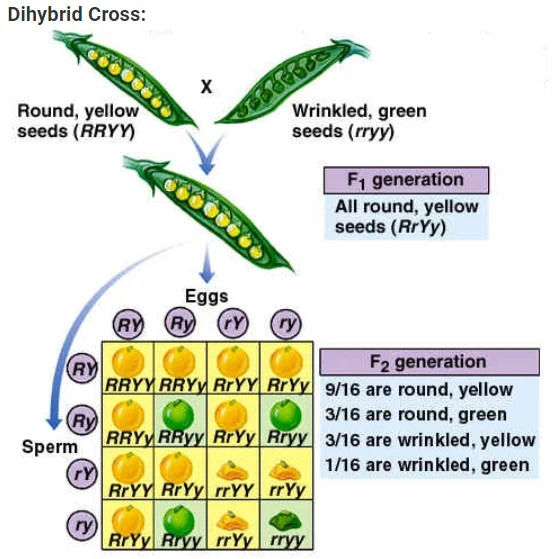- Written By
Priyanka Srivastava
- Last Modified 11-01-2025
Mendelism: Definition, Experiments & Laws
Do you know why we look like our parents and grandparents? Why does the mango seed form a mango plant and not any other plant? This is due to the fact that the genetic information of each species is unique, which helps to maintain the continuity of species. If one of the parents is black-eyed while the other is blue-eyed, then the chances of offspring having black eyes would be more. This is because of the concept of dominance. Gregor Mendel conducted many experiments on the pea plant (Pisum sativum) between 1856 and 1863. He studied the results of the experiments and deducted many observations. Based on these observations, Mendel’s laws of inheritance came into existence, also called Mendelism.
What is Called Mendelism?
Mendelism is used to refer to the theoretical tenets of heredity of the single-gene trait relating to the transmission of hereditary characteristics from parent organisms to their children, which was derived from the principle put forward by Gregor Mendel, known as Mendel’s laws. Gregor Mendel is called the ‘Father of Genetics‘. Mendel set the framework for genetics long before chromosomes or genes had been identified, at a time when meiosis was not well understood. Mendel began a decade-long research pursuit involving inheritance patterns in honeybees and plants, ultimately settling on pea plants as his primary model system.
Reasons for Choosing Pea Plant
Mendel studied the inheritance of seven contrasting characters in peas, including height, flower colour, seed colour, and seed shape. Mendel first established pea lines with two different forms of a feature, such as tall vs short height and grew these lines for generations until they were pure-breeding (always produced offspring identical to the parent), then bred them to each other and observed how the traits were inherited. Gregor Mendel believed that heredity is the result of discrete units of inheritance, and every single unit (or gene) was independent in its actions in an individual’s genome. Because of the following reasons:
1. The lifespan of a pea plant is short of about 3-4 weeks.
2. It can be grown in small areas and does not require much maintenance.
3. It reproduces by self-fertilization in normal conditions but can also be easily cross-fertilized manually.
4. It gives many offspring.
5. The seeds do not show dormancy, i.e., as soon as seeds are formed, they germinate.
6. It has seven pairs of contrasting characters. These are:-
Fig: Seven Contrasting Characters
Mendel’s Experiments
Mendel conducted two main experiments, and according to that, he formulated his laws of inheritance. These two experiments were:
1. Monohybrid Cross – The type of cross in which only one character is considered at a time is called a monohybrid cross.
2. Dihybrid Cross – The type of cross in which two characters are considered at a time is called a dihybrid cross.
Purebred plants or true-breeding plants – It refers to the plants which have gone through several processes of self-fertilization and produce offspring of the same trait. True breeding plants have identical alleles for a character.
1. Monohybrid Cross
Mendel studied one character at a time like he considered character height at a time and studied the inheritance of that character. When he crossed a pure tall plant and pure dwarf plant, then he saw all offsprings as tall. This is the F1 generation. The dwarfness character got enveloped somewhere. He did similar experiments with all the contrasting characters; he found anyone character of the parent to be expressed in the offspring.
Mendel then self-pollinated F1 progeny and surprisingly found that even the character that got masked in the F1 generation got expressed – like that of dwarf plants got expressed with tall plants when Tall F1 progeny were self-pollinated. The results he got for these monohybrid crosses were in ratio 3:1, i.e., 3 tall and 1 dwarf plant. This is called F2 generation.
Mendel said the character who was able to express themselves was called the dominant character, and the character who was masked and not expressed was called a recessive character.
Fig: Monohybrid Cross
2. Dihybrid Cross
When Mendel considered two characters at a time, he called it a dihybrid cross. Like seed shape and seed colour taken together. When Round and Yellow seed is crossed with Wrinkled and Green seed, then offspring obtained would be all Round and Yellow seed as these are dominant characters. The resulting offspring are called F1 progeny. When F1 progeny were self-fertilized, then he got F2 progeny in ratio 9:3:3:1 in which all four combinations were observed, i.e., 9 round-yellow seeds, 3 round-green seeds, 3 wrinkled-yellow seeds and 1 wrinkled-green seed.
Fig: Dihybrid Cross
Reasons for Mendel Success
- Selection of 7 contrasting characters.
- A huge or large sample size.
- Correct data analysis.
- No reference or use of linkage. If some gene was a linked gene, the ratios he drew probably would have changed.
What are Mendel’s Three Laws?
From the monohybrid cross, Mendel formulated the Law of dominance and Segregation, while from the dihybrid cross, he formulated the Law of Independent Assortment. So, Mendel’s Law are-
1. Law of Dominance
- According to Mendel, every character is controlled by factors, now called genes (pair of alleles). These factors occur in pairs.
- In a hybrid or dissimilar pair of factors, the one which expresses itself or shows its effect is called the dominant character, while the one who gets suppressed by the dominant one is called recessive character.
- So, it can be said that character or trait is determined by the dominant factor in a dissimilar pair. This is the law of dominance.
- This law helps to understand the ratio of F2 generation in both monohybrid and dihybrid cross.
2. Law of Segregation
3. Law of Independent Assortment
- Based on the observations Mendel got in a dihybrid cross, he formulated the Law of Independent Assortment.
- According to this Law, the segregation of one pair of characters during gamete formation is independent of the other pair of characters in a dihybrid cross.
- This can be explained as follows- In a dihybrid cross, two pairs of contrasting characters are considered. For example, if we take the F1 RrYy plant, then gametes produced in this plant have all possible combinations, i.e., RY, Ry, rY, ry and offsprings produced would also have all possible combinations.
Applications of Mendelism
1. It has practical application in plant and animal breeding.
2. Hybridization techniques help in obtaining improved varieties of plants that provide high yields.
3. These plant varieties are resistant to diseases and adverse climatic conditions.
4. Improvement in animal races.
5. Improved Cattle races which provide better quality and quantity of milk.
6. By the study of family pedigrees, it is possible to provide genetic counselling to parents.
7. It has application in solving the disputed parentage of the child.
Important Questions on Mendelian Genetics
Summary of Mendelism
Mendelism is used to refer to the theoretical tenets of heredity of the single-gene trait relating to the transmission of hereditary characteristics from parent organisms to their children, which was derived from the principle put forward by Gregor Mendel, known as Mendel’s laws. Gregor Mendel is called the ‘Father of Genetics’. Mendel conducted two main experiments, i.e., monohybrid and dihybrid cross. In a monohybrid cross, one character is considered at a time, while in a dihybrid cross, two characters are considered at a time.
The ratio of monohybrid cross in F2 generation is 3:1 while that of dihybrid cross is 9:3:3:1. According to Mendel, the character is controlled by a pair of factors. From the monohybrid cross, Mendel formulated the Law of dominance and Segregation, while from the dihybrid cross, he formulated the Law of Independent Assortment.
FAQs on Mendelism
Q.1. Who is known as the father of heredity?
Ans: Gregor J Mendel is known as the father of heredity.
Q.2. What is Mendelism?
Ans: Mendelism used to refer to the theoretical tenets of heredity of the single-gene trait relating to the transmission of hereditary characteristics from parent organisms to their children, which was derived from the principle put forward by Gregor Mendel in 1865, known as Mendel’s laws.
Q.3. What are Mendel’s three laws?
Ans: a. Law of Dominance
b. Law of Segregation
c. Law of Independent Assortment
Q.4. What is the importance of Mendelism?
Ans: Mendelism or Laws of Mendel have resulted in
a. Improvement in plants
b. Improvement in animals
c. Improvement in the human race
d. Disputed parentage
Q.5. What is an example of Mendelian inheritance?
Ans: A Mendelian trait refers to one that is controlled by a single locus in an inheritance pattern. In those cases, if there is a mutation in a single gene, that can cause a disease that is inherited according to Mendel’s principles. Examples are Tay–Sachs disease, cystic fibrosis, sickle-cell anaemia.
We hope this detailed article on Mendelism helps you in your preparation. If you get stuck do let us know in the comments section below and we will get back to you at the earliest.











































